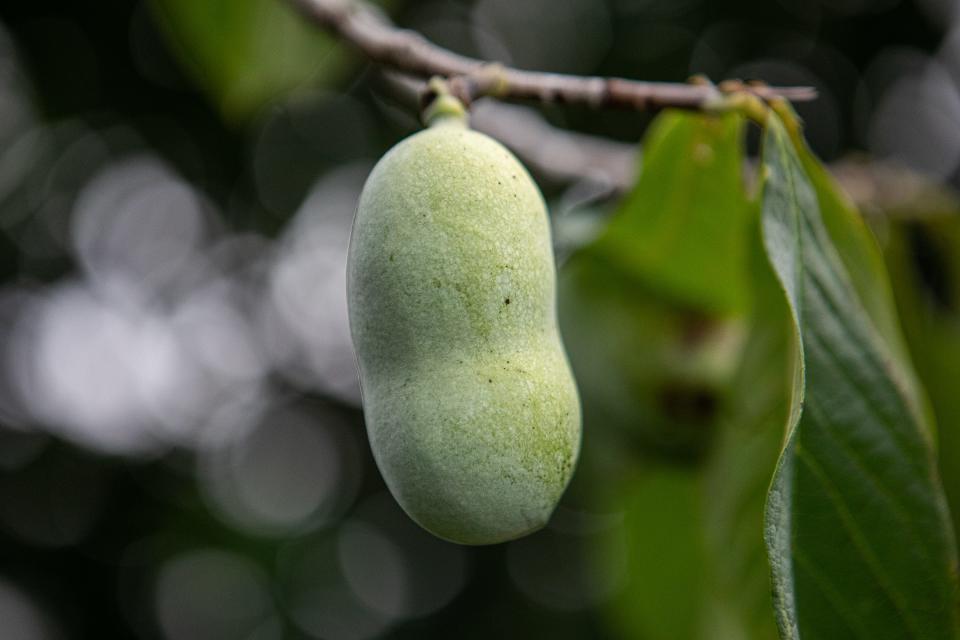Pawpaws: What you need to know about the 'Hoosier banana'
The pawpaw is one of those actual hidden gems of nature in the Midwest. You won’t often find the fruit on grocery shelves or at farm stands, despite it being the largest edible native fruit that grows within the U.S
Mass-producer food companies don’t flavor anything with pawpaw, even though there’s nothing quite like the way it tastes.
Scrub Hub: How to find and identify pawpaw trees in Hoosier forests
The fruit is everywhere in Indiana. IDNR’s Andrew Reuter said he wouldn’t be surprised if the trees were in all 92 counties.
To learn how to find them, check out the IndyStar Scrub Hub Edition published August 7, 2023.

Pawpaw’s early roots
Pawpaws were in the U.S. well before the arrival of European colonizers.
A member of Hernando de Soto’s southeastern expedition in 1541 was the first to write a report on the fruit while in the Mississippi Valley, according to the Arnold Arboretum at Harvard University: “There is a fruit through all the country … which Indians do plant,” the man wrote. “It has a very good smell, and an excellent taste.”
While the Spanish named the tree based on its resemblance to papaya, indigenous tribes called it assemina, which is now the root of its scientific name, Asimina triloba.
Today, thanks to indigenous tribes cultivating the fruits, the pawpaw can be found in the Eastern U.S. from as far north as Michigan south down to Florida and Texas
The fruit is so popular, Indiana's own Reverend Peyton's Big Damn Band wrote a song about them.
What does a pawpaw taste like?
Taste may be subjective, but if you can imagine a cross between a mango, a pineapple and a banana, you are getting close the flavor of a pawpaw.
It’s basically a Midwest tropical paradise in a soft skin.
Some people call it a custard apple for its custard-like texture, but if you’re a Hoosier, maybe you’ll want to call it an Indiana banana. They are known by similar nicknames in other Midwestern states, including Kentucky and Michigan.

What’s the best way to eat pawpaw?
Harvesting pawpaw is as easy as giving the tree a shake. They trees aren’t very big, but make sure you don’t shake them onto your head.
Pawpaw fruit can be eaten raw, but it spoils quickly after picking, so eat them within a day or two. Ambitious foragers can whip up some recipes with the fresh fruits, or they can be peeled, deseeded and frozen to use later.
Here’s a simple pawpaw custard pie recipe that was originally published in the Detroit Free Press:
Pawpaw Custard Pie
1 c. 2% milk
1 c. cream
3 eggs
¾ c. sugar
1 c. pureed pawpaw pulp
Mixing the ingredients as you add them, beat together the milk, cream, eggs, sugar and pawpaw. Pour the custard into a pie shell and bake at 450 F for 15 minutes, then reduce the heat to 325 F and bake an additional 40 minutes or until a knife inserted near the center of the pie comes out clean.
Pawpaws in the wild
The pawpaw tree loves rich, moist soils in lowland woods, but the trees can move to the uplands if the area is heavily browsed by deer. Deer don’t eat pawpaw and give the tree ample room to spread out.
It’s likely found in every Indiana state park along the trails, but not all of them will fruit.
The flowers, a brownish-purple don’t smell great, so the trees are pollinated by flies and beetles — anything attracted to the fetid stench. Flowers bloom early in the spring as leaves start to appear.
Pawpaw clusters are identical clones
The trees spread out through root shoots, so a stand of trees will likely be genetically similar, which means one copse relies on insects to carry pollen over from a genetically different copse.
And because the fruit has high nutritional value, wildlife like fox, opossum and raccoon will spread the seeds throughout an area as the seeds won’t be fully digested.
The species is found all over the Eastern United States, and is not threatened or endangered, but it’s always a good idea to not heavily forage one area. DNR’s Reuter said think of the 50/50 rule: never take more than half of what you find.
Karl Schneider is an IndyStar environment reporter. You can reach him at karl.schneider@indystar.com. Follow him on Twitter @karlstartswithk
IndyStar's environmental reporting project is made possible through the generous support of the nonprofit Nina Mason Pulliam Charitable Trust.
This article originally appeared on Indianapolis Star: Hoosier pawpaws: 5 things to know, plus a homegrown song and recipe
